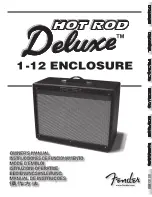
ARRAY CONFIGURATIONS
EASE data is available on all KI series
speakers at KLIPSCH.COM/PRO. Klipsch
urges users to refer to this data when
determining how specific speaker systems
should be installed for optimum performance.
Although toed-out suggestions for coverage
patterns are suggested below, these
loudspeakers do not necessarily have to be
toed-out when installed in an array. There
can be pattern overlap, which will increase
output in that region, although with lobing
side effects.
NOTE: EACH SPEAKER SHOULD BE
SUSPENDED INDIVIDUALLY WHEN
FORMING THE LOUDSPEAKER ARRAY.
The KI-102-SMA-II, KI-362-SMA-II and
KI-396-SMA-II systems have horizontal
coverage patterns of 90º. The side panels
are angled at 22.5º, so two speakers tightly
aligned create a 45º angle between the axes.
As this accounts for only half of an individual
speaker’s total coverage angle, the speakers
would need to be toed-out to 90º (included
angle), to provide the smoothest pattern and
180º of total coverage.
The KI-262-SMA-II has a 60º coverage
pattern, with side panels angled at 22.5º. Two
enclosures tightly aligned create an angle of
45 degrees, and therefore would need to be
toed out an additional 15 degrees (included
angle) to form a 60º angle between axes,
creating 120º total coverage.
The KI-172-SMA-II and KI-272-SMA-II are
asymmetrical enclosures, and therefore offer
multiple mounting angle options. Note that
their coverage patterns are the same as the
KI-102-SMA-II and KI-262-SMA-II, respectively.
Please refer to the EASE data on
KLIPSCH.COM/PRO for specific coverage
pattern information on the KI-115-SMA-II and
KI-215-SMA-II low-frequency enclosures. The
KI-215-SMA-II matches the KI-362-SMA-II
enclosure form.
Klipsch recommends that power provided to the
speakers not exceed the values indicated in the
specifications by more than 3dB. If continuous
power or thermal ratings are exceeded, the
internal protective KLIP circuit will shut down the
high- or high/mid-frequency sections. These will
remain shutdown until input power is reduced
significantly. The KLIP circuit monitors continuous
average power. Although unlikely, it is possible to
create a situation where extreme transient signals
could damage componenet diaphragms before
triggering the KLIP protection circuit.
(KI-396-SMA-II does not feature KLIP circuit driver
protection) USE CAUTION WITH HIGH POWER!
Damage can also occur due to distortion generated
from underpowering, i.e. overdriving with too
little power. Klipsch recommends that amplifier
headroom be based on values 3dB above the
maximum speaker power ratings, or twice the
published numerical power rating of the speaker.
For example, the KI-102-SMA-II is rated at 200
watts continuous. A 3dB continuous headroom
factor would suggest a 400-watt amplifier.
POWER REQUIREMENTS


























